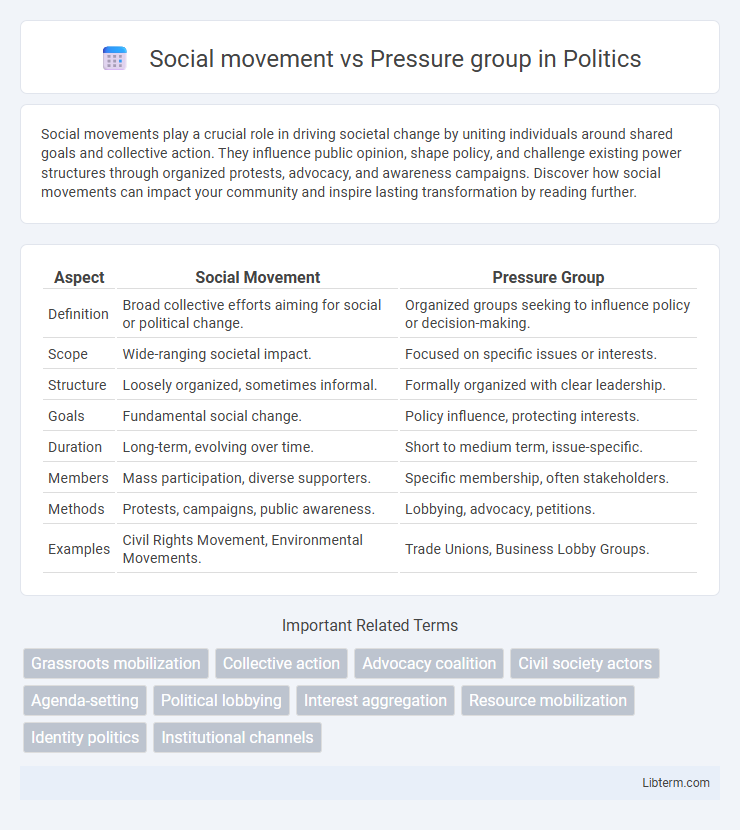Social movements play a crucial role in driving societal change by uniting individuals around shared goals and collective action. They influence public opinion, shape policy, and challenge existing power structures through organized protests, advocacy, and awareness campaigns. Discover how social movements can impact your community and inspire lasting transformation by reading further.
Table of Comparison
| Aspect | Social Movement | Pressure Group |
|---|---|---|
| Definition | Broad collective efforts aiming for social or political change. | Organized groups seeking to influence policy or decision-making. |
| Scope | Wide-ranging societal impact. | Focused on specific issues or interests. |
| Structure | Loosely organized, sometimes informal. | Formally organized with clear leadership. |
| Goals | Fundamental social change. | Policy influence, protecting interests. |
| Duration | Long-term, evolving over time. | Short to medium term, issue-specific. |
| Members | Mass participation, diverse supporters. | Specific membership, often stakeholders. |
| Methods | Protests, campaigns, public awareness. | Lobbying, advocacy, petitions. |
| Examples | Civil Rights Movement, Environmental Movements. | Trade Unions, Business Lobby Groups. |
Definition of Social Movements
Social movements are organized collective efforts by large groups of people aiming to promote or resist social change, often driven by shared values and long-term goals. Pressure groups, in contrast, are organized entities focused on influencing specific policies or decisions without broader social transformation ambitions. Social movements typically engage in sustained public campaigns and grassroots activism, seeking to reshape societal norms and institutions.
Definition of Pressure Groups
Pressure groups are organized bodies that seek to influence public policy and decision-making without directly seeking political office. Unlike social movements, pressure groups often have a specific interest or cause, employing lobbying, advocacy, and public campaigns to shape legislation. Their goals are usually more focused and narrowly defined compared to the broader societal change aimed by social movements.
Key Differences Between Social Movements and Pressure Groups
Social movements are broad, informal networks aiming for large-scale social change, while pressure groups are organized, formal entities focused on influencing specific policies or decisions. Social movements mobilize mass participation over extended periods, whereas pressure groups often target policymakers directly with lobbying and advocacy efforts. The scope of social movements encompasses societal transformation, whereas pressure groups concentrate on achieving particular objectives within the political system.
Objectives and Goals
Social movements seek broad societal change by mobilizing large groups around shared values and long-term objectives such as civil rights or environmental protection. Pressure groups focus on influencing specific policies or decisions within political institutions, aiming for targeted, often short-term goals like legislative amendments or regulatory changes. Both operate to effect change, but social movements emphasize transformative ideals while pressure groups concentrate on pragmatic, issue-specific outcomes.
Organizational Structure
Social movements typically exhibit a decentralized and flexible organizational structure, allowing for broad participation and spontaneous collective actions. Pressure groups often maintain a formal, hierarchical organization with specialized leadership and defined membership roles to influence policy decisions effectively. The structural differences impact their strategies, with social movements favoring grassroots mobilization and pressure groups relying on targeted lobbying efforts.
Methods and Strategies
Social movements employ broad-based methods such as mass protests, demonstrations, and digital campaigns to mobilize public opinion and create widespread societal change. Pressure groups focus on targeted strategies including lobbying policymakers, engaging in direct negotiations, and using legal challenges to influence specific legislation or decisions. Both utilize media outreach, but social movements prioritize grassroots activism while pressure groups emphasize expert advocacy and insider connections.
Membership and Participation
Social movements typically involve large-scale collective actions with broad membership drawn from diverse social strata, emphasizing mass participation and sustained commitment to societal change. Pressure groups consist of more organized, smaller, and often specialized memberships focused on influencing specific policies or decisions through targeted lobbying and advocacy. Participation in social movements is usually more fluid and spontaneous, while pressure group members often engage through formal structures and strategic campaigns.
Impact on Policy and Society
Social movements drive broad societal change by mobilizing large populations to challenge existing norms, often leading to significant shifts in public policy and cultural attitudes over time. Pressure groups focus on influencing specific policies or decisions within established political frameworks, employing targeted lobbying and advocacy to achieve incremental policy changes. Both play crucial roles in shaping governance, with social movements fostering widespread awareness and long-term transformation, while pressure groups effect immediate policy adjustments through specialized expertise and political access.
Case Studies: Examples of Each
The Civil Rights Movement in the United States exemplifies a social movement aimed at broad societal change through mass mobilization and advocacy for racial equality. The National Rifle Association (NRA) serves as a pressure group focused on influencing legislation and public policy regarding gun rights. Social movements tend to inspire widespread cultural shifts, while pressure groups operate strategically within political systems to advance specific interests.
Role in Democratic Processes
Social movements play a crucial role in democratic processes by mobilizing large groups of people to demand systemic change and influence public policy through collective action and advocacy. Pressure groups, in contrast, focus on representing specific interests or causes by lobbying government officials and shaping legislation without necessarily seeking broad societal transformation. Both contribute to democracy by enhancing citizen participation, ensuring diverse voices are heard, and holding political institutions accountable.
Social movement Infographic

 libterm.com
libterm.com